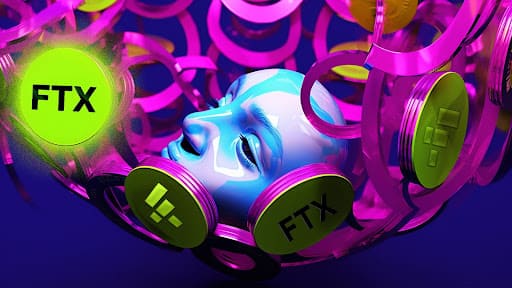
The principles of bear and bull markets govern the behaviors of investors and stakeholders in the stock market, and it is not all too different in the cryptocurrency market. Even as a beginner, you might have heard the terms 'bull run' and 'bearish market', and wonder what they mean.
The bull and bear refer to trends in the cryptocurrency and stock market, depending on whether there is a general surge or dip in a token or stock's value. Because such markets are constantly moving, analysts use such terms to describe the market activity.
What Is A Bull Market?
The term 'bull' in financial analysis came from how a bull constantly fights against opposition. A bull market or trend is one where the market continues to trend upward over a period of time. To conclude that a market is bullish, the trend is supposed to be sustained over a period, and about 20% over its recent performance.
For example, in the image below, we can say Bitcoin was in a bull market from October 2020 to April 2021. The price of BTC keeps making series of higher highs and trending up.
Source: Tradingview
Here are some markers used to identify a bullish market:
-
-
Investor Confidence
-
Bull markets are often characterized by hope from investors. The general mood in the market is positive, and investors are hopeful that the price of the token or stock goes up in the long run. So there is mass purchasing of that token, which ultimately results in a spike in price.
Most times, the media contributes to investor confidence by stating positive trends for individual tokens or a particular sector. For example, JP Morgan analysts stated that Bitcoin would get to about $148,000 in value and that started a bull run for the token early in 2023.
Other times, a fear of missing out on the bull trend makes other investors jump on an investment. This occurs later in the trend, as the token gathers more momentum and rises on the price charts.
-
-
Economic Factors
-
Most bull runs are associated with marked economic growth, such as reduced unemployment rates, fast-growing industries and firms, and increased investment in a particular market. These are often accompanied by innovation and advanced technology in the sectors, which make the entire market bullish.
For the cryptocurrency market, increased investment in a token, coupled with positive news, are major drivers of bullish trends.
-
-
Commodity Pricing
-
Because there is confidence around investment, the prices of stock and tokens in the market tend to rise with positive trends. The price surge is one of the most obvious markers of a bull market, as most coins will reflect above-average pricing during a bullish trend.
An example is the bull run between 2020 and 2021, where Bitcoin, Ethereum, and most altcoins recorded their all-time highs. The entire cryptocurrency market reached a peak market cap of about $3 trillion.
What Is A Bear Market?
A bear market is the opposite of a bull market and is characterized by prolonged downward or negative activity in market activity, up to 20% down from the previous performance. Here, investors are offloading their assets, trying to cut their losses, or anticipating lower values in the future.
Source: Tradingview
The markers for a bearish market include:
-
-
Loss of Confidence
-
Parallel to the bull market, investors in a bearish market are expecting the prices of the tokens to dip even further than the current level, and they sell their assets to minimize the loss they have incurred. Of course, the more investors sell a token, the more the price dips.
Like in a bullish market, the media plays a huge role in spreading the downtrends, influencing even more investors to dump the cryptocurrency. Fear is the vital emotion here, unlike the bullish market where investors' greed predominates.
Bitcoin's bearish run in 2022 is one classic example of fear driving a bearish market, as most investors sold their assets for fear that BTC would hit even worse lows.
-
-
Economic Features
-
Bearish markets are often marked by stagnant or declining industries, even as bad as a recession. There might be inflation, higher unemployment rates, and higher interest rates from banks. During these times, keeping fiat currencies might be a more viable option than investing in assets.
Throw in bad press, and the bearish wave keeps rocking the crypto-verse.
-
Token Pricing
Like in bullish markets, token prices are the most basic definitions of a bearish market. The continued sale of a particular token will eventually lead to its low price tags, especially with the increased publicity from the media.
Source: Tradingview. Apecoin Daily Time Frame from April 2022 to August 2023
For example, ApeCoin has been on a bearish trend since its launch in 2022, as more investors are losing confidence in the token's prospects. Another example in cryptocurrency is the downturn that most meme coins experience after their initial launch price pump.
Bearish vs. Bullish Markets: When Should I Invest?
Generally, stock markets are very volatile, and the cryptocurrency market is even more so, with the media playing a significant role in price fluctuations. So it is important to monitor crypto news and charts before starting an investment.
A key attribute of successful crypto traders is knowing when to buy or sell a particular token and which token to invest in. There are often many analytical reports, often daily and weekly, on the performances of various assets on the crypto charts.
With real-time trading services on centralized and decentralized exchanges, it is easier for traders to identify basic bearish or bullish trends using certain indices. Most exchanges also offer advanced trading options, where you can trade with assets that are more resistant to market fluctuations.
Conclusion
Bullish and bearish markets simply refer to transient phases of market activity, where investors' attitudes and token prices are key indicators. In bullish markets, there is increased growth of individual tokens, which reflects on the general market outlook, and investors are hopeful for even higher prices.
On the other hand, bearish trends are dominant in recessions, where there are negative economic features, along with poor investor moods. Distinguishing the markets from one another is crucial to making good investment decisions.
Want more top-tier cryptocurrency content?
Follow Us: X TikTok Instagram Telegram LinkedIn
Sign up to our newsletter at the bottom of the page
Check Out Our Top 10 Crypto Currencies of 2023
This article is intended for educational purposes and is not financial advice.

















